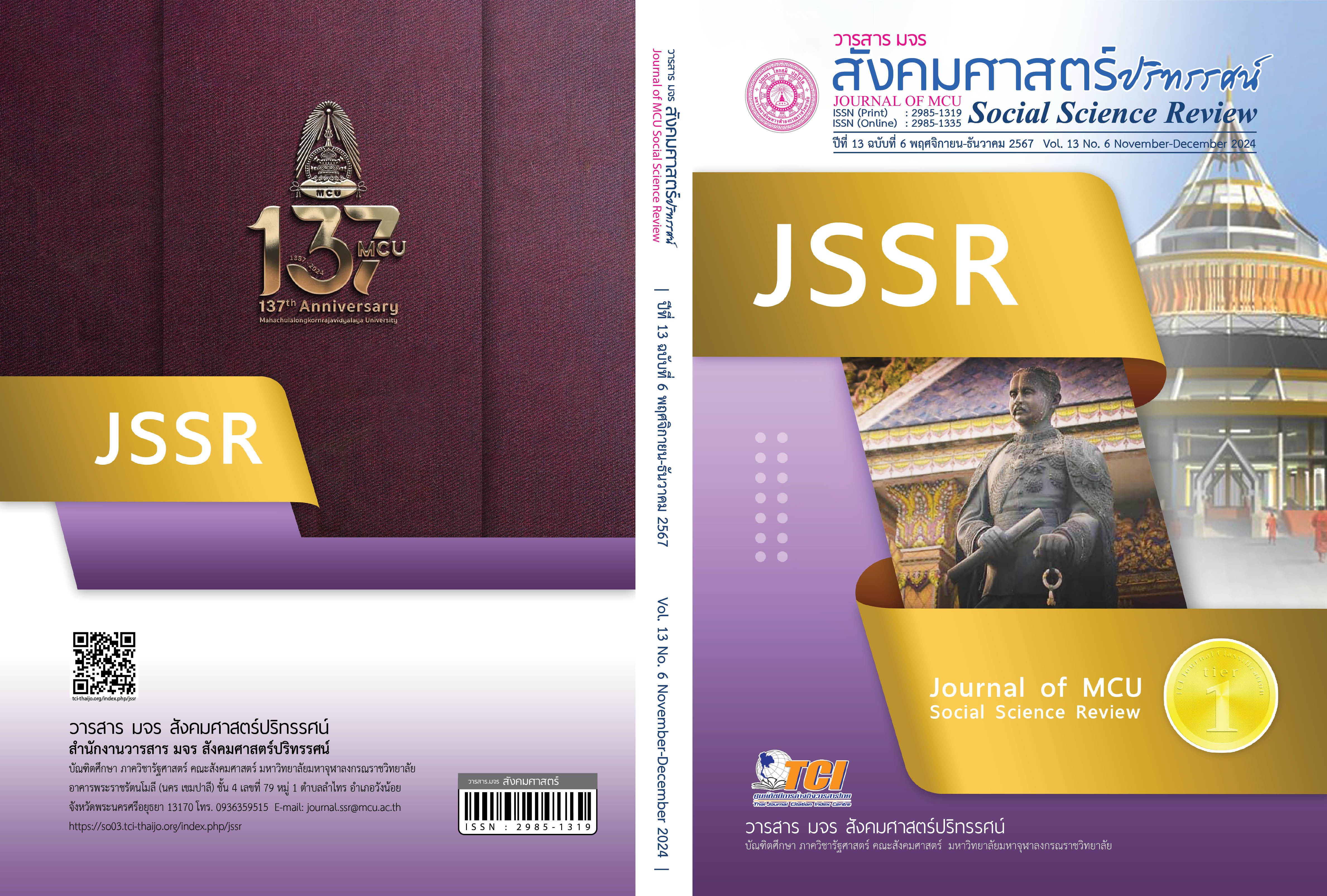THE DEVELOPMENT MODEL OF THE MORAL SCHOOL MANAGEMENT IN A NEW ERA UNDER THE KALASIN SECONDARY EDUCATIONAL SERVICE AREA OFFICE
Keywords:
Model Development, Moral School Management, Moral School in New EraAbstract
Objectives of this research article were: 1. To study basic information on moral school management in a new era 2. To create and verify the suitability of the model 3. To tryout the model and 4. To evaluate the model. The sample group consisted of 9 experts and 182 administrators and teachers under the Kalasin Secondary Educational Service Area Office. The research instruments included questionnaires, interview, focus group discussion and performance assessment form.
The research results were found that components of moral school management in a new era had 5 elements and 27 indicators, including Component 1, Moral school planning in a new era with 5 indicators. Component 2, Transforming the implementation mechanism with 7 indicators. Component 3, Determination of supervision and monitoring with 5 indicators. Component 4, Creating a moral development network in a new era with 5 indicators. Component 5, Performance evaluation with 5 indicators. The overall suitability assessment result was at the highest level. The transformation of implementation mechanism had the greatest need. The moral school management model in a new era consisted of 5 parts: 1. principles and concepts, 2. objectives, 3. methods of operation, 4. evaluation, and 5. conditions for success. The overall suitability evaluation and possible results of the model were at the highest level. Also, it was found that the knowledge evaluation results of the participants after receiving the development were higher than before receiving the development, with statistically significant level of 0.05 and the satisfaction was at the highest level. As for the evaluation of the school administrators’ model, it was at the highest level of usefulness.
References
ชาญชิต ทับหมี. (2564). รูปแบบการพัฒนาการบริหารโรงเรียนคุณธรรม สังกัดสำนักงานเขตพื้นที่การศึกษาประถมศึกษาในเขตภาคเหนือ. วารสารสังคมศาสตร์และมานุษยวิทยาเชิงพุทธ, 7(7), 344-358.
ธนสาร บัลลังก์ปัทมา. (2563). รูปแบบการบริหารงานโรงเรียนคุณธรรมของผู้บริหารสถานศึกษาสังกัดสำนักงานเขตพื้นที่การศึกษาประถมศึกษา (ดุษฎีนิพนธ์ศึกษาศาสตรดุษฎีบัณฑิต สาขาวิชาบริหารการศึกษา). นครปฐมฯ: มหาวิทยาลัยมหามกุฏราชวิทยาลัย.
นรินทร์ ขวัญคาวิน และคณะ. (2565). การพัฒนารูปแบบการบริหารโรงเรียนคุณธรรมอย่างยั่งยืน. วารสารมนุษยศาสตร์และสังคมศาสตร์ มหาวิทยาลัยนครพนม, 12(3), 164-181.
บันลือ โกมลศรี และคณะ. (2564). รูปแบบการบริหารโรงเรียนคุณธรรมในโรงเรียนมัธยมศึกษาขนาดเล็ก สังกัดสำนักงานคณะกรรมการการศึกษาขั้นพื้นฐานที่มีประสิทธิผล. วารสารสันติศึกษาปริทรรศน์, 9(7), 2993-3007.
มูลนิธิยุวพัฒน์. (2564). หลักการและกระบวนการพัฒนาโรงเรียนคุณธรรม 4+6 โมเดล (พิมพ์ครั้งที่ 5). กรุงเทพฯ: สหมิตรพริ้นติ้งแอนด์พับลิสซิ่ง.
วาโร เพ็งสวัสดิ์. (2553). การวิจัยพัฒนารูปแบบ. วารสารมหาวิทยาลัยราชภัฏสกลนคร, 2(4), 1-16.
ศูนย์คุณธรรม (องค์การมหาชน). (2564). รายงานสถานการณ์คุณธรรม ปี 2564. กรุงเทพฯ: ศูนย์คุณธรรม (องค์การมหาชน).
ศูนย์ปฏิบัติการต่อต้านการทุจริต กระทรวงศึกษาธิการ. (2560). แผนปฏิบัติการส่งเสริมคุณธรรม กระทรวงศึกษาธิการ ประจำปีงบประมาณ พ.ศ. 2564. กรุงเทพฯ: กระทรวงศึกษาธิการ.
สวัสดิ์ วันภูงา. (2564). การพัฒนารูปแบบการใช้ชุมชนการเรียนรู้ทางวิชาชีพสำหรับสถานศึกษาขั้นพื้นฐาน (ดุษฎีนิพนธ์ศึกษาศาสตรดุษฎีบัณฑิตต สาขาวิชาการบริหารและพัฒนาการศึกษา). มหาสารคาม: มหาวิทยาลัยมหาสารคาม.
สำนักงานเขตพื้นที่การศึกษามัธยมศึกษากาฬสินธุ์. (2565). แผนปฏิบัติการประจำปีงบประมาณ พ.ศ. 2564. กาฬสินธุ์: หยกศึกษาภัณฑ์และการพิมพ์.
สำนักพัฒนานวัตกรรมการจัดการศึกษา. (2560). แนวทางการขับเคลื่อนโครงการโรงเรียนคุณธรรม สพฐ. กรุงเทพฯ: สำนักพัฒนานวัตกรรมการจัดการศึกษา.
Downloads
Published
How to Cite
Issue
Section
License
Copyright (c) 2024 Journal of MCU Social Science Review

This work is licensed under a Creative Commons Attribution-NonCommercial-NoDerivatives 4.0 International License.
In order to conform the copyright law, all article authors must sign the consignment agreement to transfer the copyright to the Journal including the finally revised original articles. Besides, the article authors must declare that the articles will be printed in only the Journal of MCU Journal of Social Sciences. If there are pictures, tables or contents that were printed before, the article authors must receive permission from the authors in writing and show the evidence to the editor before the article is printed. If it does not conform to the set criteria, the editor will remove the article from the Journal without any exceptions.





